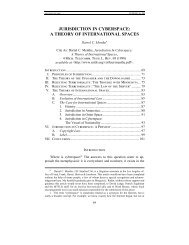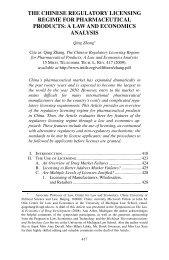Fracking Patents - Michigan Telecommunications and Technology ...
Fracking Patents - Michigan Telecommunications and Technology ...
Fracking Patents - Michigan Telecommunications and Technology ...
- No tags were found...
Create successful ePaper yourself
Turn your PDF publications into a flip-book with our unique Google optimized e-Paper software.
Spring 2013] <strong>Fracking</strong> <strong>Patents</strong> 319practice might interact with host materials. 276 There are numerous “chemical<strong>and</strong> physical reactions that can occur in the open wellbore, induced fractures,natural fractures, <strong>and</strong> the surrounding matrix . . . as a result of interactionsbetween fracture fluids <strong>and</strong> the geologic target formations during the hydraulicfracturing process.” 277 For instance, formation waters are variablewithin <strong>and</strong> between formations, including concentration levels of the mostcommon VOCs <strong>and</strong> semi-VOCs. 278 Likewise, drilling <strong>and</strong> hydraulic fracturing“causes fluid-rock interactions that have the potential to mobilize heavymetals,” such as barium, uranium, chromium, <strong>and</strong> zinc, that are naturallyenriched in the shale formation. 279 However, the only way to determine theextent to which these heavy metals are mobilized during fluid-rock reactionsis to perform extraction studies “using a measured mass of ground <strong>and</strong>sieved shale <strong>and</strong> a known volume of chemical extractant.” 280Although many reactions in wells are subject to normal catalytic <strong>and</strong>restriction influences, others are subject to “a set of specific limiters that arefound in few other places in [the] chemical industry.” 281 For instance, theinfluences of temperature <strong>and</strong> pressure are reasonably predictable, but “otherreaction controls such as reaction rate are strongly influenced by the area<strong>and</strong> mixing constraints described by the location of the reaction, the area-tovolumeratio <strong>and</strong> the behavior <strong>and</strong> stability of the byproducts,” all of whichcan only be assessed by putting the products in question to use in real-worldsettings. 282 Similarly, “degradation reactions” related to well construction<strong>and</strong> pipe <strong>and</strong> cement stability cannot be easily assessed, even with formationaccess. 283 “Re-precipitation compounds” must also be considered. 284 Again,given the many complexities <strong>and</strong> uncertainties involved, such interactionhazards can only be assessed in the field during actual hydraulic fracturing276. U.S. ENVTL. PROT. AGENCY, EPA/600/R-11/122, PLAN TO STUDY THE POTENTIALIMPACTS OF HYDRAULIC FRACTURING ON DRINKING WATER RESOURCES 40 (Nov. 2011).277. U.S. ENVTL. PROT. AGENCY, EPA/600/R-11/066, PROCEEDINGS OF THE TECHNICALWORKSHOPS FOR THE HYDRAULIC FRACTURING STUDY: CHEMICAL & ANALYTICAL METHODS10 (May 2011).278. Nancy Pes Coleman, Produced Formation Water Sample Results from Shale Plays,U.S. ENVTL. PROT. AGENCY, http://water.epa.gov/type/groundwater/uic/class2/hydraulicfracturing/upload/producedformationwatersampleresultsfromshaleplays.pdf (last visited Mar. 1,2013).279. Tracy L. Bank, Trace Metal Geochemistry <strong>and</strong> Mobility in the MarcellusShale, U.S.ENVTL. PROT. AGENCY, http://www.epa.gov/hfstudy/tracemetalgeochemistry<strong>and</strong>mobilityinthemarcellusformation1.pdf (last visited Mar. 1, 2013).280. Id.281. George E. King, Fracture Fluid Additive <strong>and</strong> Formation Degredations, U.S. ENVTL.PROT. AGENCY, http://www.epa.gov/hfstudy/fracturefluidadditives<strong>and</strong>formationdegradations.pdf (last visited Mar. 1, 2013).282. Id.283. Id.284. Id.






